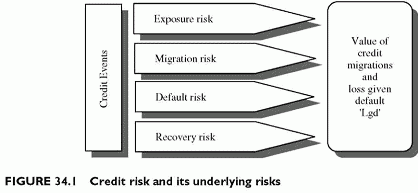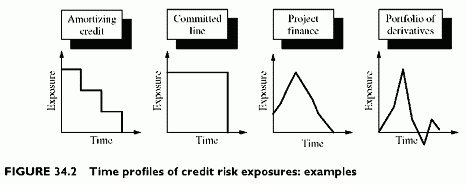EXPOSURE RISK
Category: Risk Management in Banking
The first ingredient of credit risk is exposure, which is the amount at risk with the counterparty. In practice, exposure is the most common information variable for credit risk. Credit risk management imposes limits on exposures by firm, industry or region. Exposure is the quantity of risk. Nevertheless, defining what it is raises issues.
Exposures are either at book value or at mark-to-model values.
Valuation of losses under book value ignores migration risk, and results in loss under default only. It is desirable to capture changes in credit standing, which do not materialize in the book value, but alter the default probability of a borrower. Marking-to-model exposures serve for valuing migrations, by discounting future flows from assets at a discount rate, adding the credit risk spread to the risk-free rate. Credit risk models capturing migration are full valuation models. Those using book values are default models. Valuation remains partial only because it usually refers to the credit risk component without considering interest rate movements and their values on the exposures. A full mark-to-market would include interest rates and risk premium changes in valuation, creating value volatility independent of credit risk. This would make it difficult to isolate the credit risk component.
Only future exposures are at risk by definition. This raises the issue of how to deal with uncertain exposures, such as future draws on a credit line for the banking portfolio or derivatives credit risk. Rules serve to characterize the Exposure At Default (EAD).
Exposures for the market portfolio raise other issues because they are market-driven and tradable instruments can be sold at any time. For over-the-counter instruments, any positive liquidation value is the loss in the event of default of the counterparty. These exposures are market-driven, making it necessary to model their time profile under various market conditions. Best practices consider the highest potential values at several time points at a preset confidence level.
The time profile of exposures varies widely with the type of transactions. Figure 34.2 illustrates some possible shapes based on authorization profiles (not projections), either for amortizing loans or for committed lines whose usage is uncertain.
Chapter 39 develops the modelling of exposures for market instruments.


